Keeper review
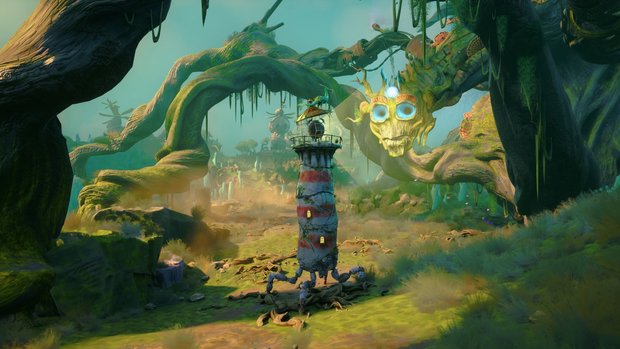
- 0 Comments
Stunning genre-bender from Lee Petty and Double Fine shines brightly in all the right ways
The celebrity face of Double Fine Productions is rightly Tim Schafer, but out of the limelight artist/designer Lee Petty has been quietly carving out quite a portfolio for himself as well, with key art credits ranging from Psychonauts 2 to Brütal Legend to Broken Age, and perhaps even more impressively as the project lead for Headlander and the imaginative 2011 adventure, Stacking. For his latest directorial effort, Petty trades in Russian nesting dolls for a living lighthouse on a dying world, and it’s an utterly unforgettable experience. Not only is Keeper a wonderfully surprising genre-defying adventure/platformer/something, it’s so strikingly gorgeous and so vividly, creatively designed that I’m starting to wonder if Petty is really an alien among us writing a visual love letter to his home planet. Either way, it’s a memorable, mesmerizing trip that never stopped delighting me from beginning to end.
Actually, I think Keeper is supposed to take place on Earth, albeit an Earth many millennia after mankind has disappeared. It’s hard to say exactly where or when, as much of the wordless story is left purely to interpretation, apart from little descriptive snippets of lore when earning achievements. But really it doesn’t matter, as the landscape has changed SO much as to be practically unrecognizable. There’s still the odd bird, fish, or other familiar creature here and there, but mostly this place feels like a massive mutation of the organic and mechanical alike. Ancient ruins are now so overrun by plant life that they’ve become a natural part of the landscape, while the flora and fauna feel like a significant evolution of this world’s exotic, (extra)terrestrial lifeforms. Some of the latter aren’t entirely original – been there, done that with the floating sky jellyfish – but it’s an intriguing collection of such things as skittish rock critters, hungry sentient turnips, many-eyed trees and giant snails or turtle-like creatures that float majestically through the air.
But something is wrong here, too. A blight, or “Wither” as the game refers to it, has begun to spread over the land, sending gooey tendrils and swarms of locust-like bugs to infest and infect. This land needs a hero to save it from destruction and decay, so obviously the task falls to… a lighthouse? Indeed, certainly not your standard Chosen One – it’s not even a manned lighthouse, but nor does it need to be. When an odd-looking seabird inadvertently causes it to lean, crumble, and collapse to the ground, you’d think that’d be that, but instead the old decrepit tower magically begins to stir, reform, sprout crab-like legs and move! Not very well, mind you. Your first few minutes of life with a new set of appendages will have you staggering and flopping more than a drunken sailor, but once accustomed to your newfound form, you’re off and running toward the towering mountaintop in the distance that is able to beckon you through mystical visions.
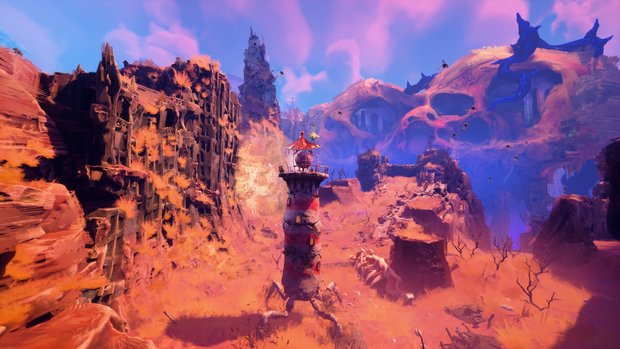
As remarkable a lighthouse as you are, you ARE still a lighthouse, after all, so your abilities are limited. You’re not very fast, even at “dash” speed to break through weaker impediments (like old houses in your way), and though you can climb manageable ledges you cannot jump (at least until later). What you can do, of course, is shine a light beam you can aim and focus, which seems to have some restorative properties, causing small plants to quiver and bloom. To the Wither, however, your light is destructive, causing purple-black tendrils to burst or swarming pests to scurry away or even dissipate entirely. Certain machine receptacles, too, can be triggered by your beams, causing them to raise bridges or otherwise further enable your progress in some way.
But still, you’re a lighthouse with no hands, so you can’t do this alone. Fortunately your seabird pal sticks around for the journey, snuggling on top of the lighthouse after having been separated from its family. The bird (which the game names Twig, though no one ever articulates it as such) has limited abilities as well, but it can fly and be directed to conveniently highlighted objects to retrieve or manipulate, such as levers and cranks. Many of the game’s puzzles involve finding the correct energy sources to power machines (or monsters) up, then positioning them just so in order to continue. Sometimes this involves solving little minigames that feel most like a traditional adventure, such as rotating gears to align an image, guiding a lever through a maze-like series of slots, or organizing themed talismans into the proper sequence with limited room to maneuver.
Even with these minor puzzle-solving diversions, I was sailing through the first couple hours of Keeper, enjoying the heck out of it but knowing that many players would complain about its lack of substantive gameplay. But a funny thing happened on the way to the mountain: it got harder, deeper, better. I’ll leave the many surprises for players to discover, but once they start they never stop, in ever more delightful ways. The puzzles get far more complex, with more moving parts involved – less minigame, more living game played out in the environments themselves, such as coordinating three different light beams on a single target, or performing the right actions to trick water-floating critters to follow you to your desired destination.
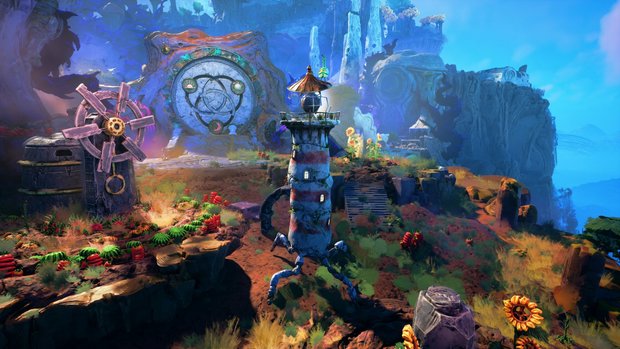
There’s also a great time-distortion segment across three separate temples in a Machinarium-esque village of robots. Activating certain orbs lets you either rewind time to a point many years earlier or fast-forward to many years later. As an inorganic construct, this has little impact on an ancient beat-up old lighthouse, but it drastically alters the terrain and wreaks havoc on your avian companion. It’s great fun to continually juggle between Twig’s time-twisted variations to affect the necessary requirements for progress.
But that’s just scratching the surface of how unique and different and utterly bonkers the game gets. Your lighthouse form takes a beating from all its ordeals, in unavoidable ways, but whatever miraculous powers granted you life in the first place are able to reconstruct you in other ways later on, allowing you to traverse water, ride air vents, and eventually yes, even jump. And even that doesn’t hold a candle to the final lengthy sequence, which is completely unlike anything that came before, including the game’s ultimate “boss fight.” Again, I’ll leave it to you to discover the details for yourself, but let’s just say I wasn’t expecting Sonic the Hedgehog, however temporarily… but I’m sure glad it happened!
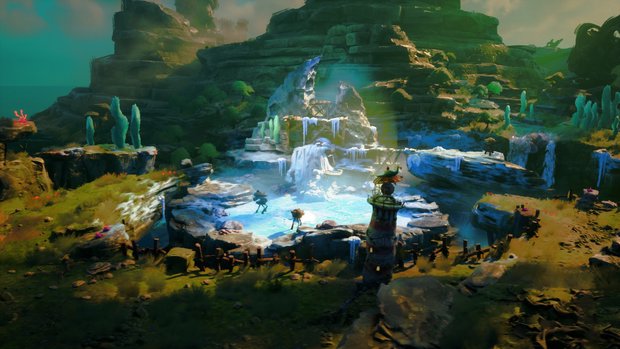
If it’s starting to sound like Keeper becomes more and more action-oriented the further it goes along, that’s because it does. This will disappoint some adventure gamers, especially those who start out comfortably enjoying the far less physically taxing first few hours. But at least until the endgame, it should all still be pretty manageable even for someone who’s all thumbs. (And I do recommend playing with a gamepad, though keyboard/mouse is an option as well.) The final few levels certainly demand a degree of hand-eye coordination not previously required, but this is no (original) Meat Circus from Psychonauts, suddenly ratcheting up to insane difficulty. It’s still largely a matter of planning; it might just need a bit of practice to get right. There’s never (okay, almost never) anyone fighting back, and one whole high-speed sequence involves winding pathways with bumpers preventing you from tumbling off.
I’m glad the whole game doesn’t play out at top speed, though, not just for gameplay reasons but because Keeper is so incredibly gorgeous to look at. There’s a whole team of artists listed in the credits, but it’s here that Lee Petty’s own influence as an artist is most keenly felt. Every postcard-worthy scene is packed with detail using the boldest, most vivid depictions imaginable, and biomes aren’t so much constantly changing as they are woven together in a cohesive, seemingly impossible tapestry. With very few breaks for level loads, one minute you’ll be wafting through a low-gravity landscape of pink pollen as far as the eye can see, the next you’re wading through the rising waters of a shadowy grotto, bracing yourself along wind-swept mountains, plunging beneath the waves to be carried by the current, plowing through the dusty skeletons of long-dead desert animals, or gazing out from the top of a waterfall over the ruined husk of a former city metropolis. Short cutscenes are liberally sprinkled in as well for dramatic effect, but never overdone.
It all looks believably realistic (in a completely alien or far-future post-apocalyptic way) from a distance, and yet even screenshots don’t do the graphics justice. Up close there’s a raw painterly effect with visible brush strokes, perhaps a bit of ink hatching and an almost concept-art look. The lack of photographic clarity is obviously intentional, and rather than feeling unrefined it works to give the game an even more fantastical aesthetic. As does the colour, colour, colour everywhere! It’s like an artist’s palette with every conceivable hue exploded onto a canvas, then skillfully worked into a coherent, cohesive environment. Backdrops may be orange sunsets, lush green valleys, phosphorescent caverns, or grim blue graveyards, but within each is its own entire spectrum of colourful detail. It reminded me somewhat of the old Robin Williams film What Dreams May Come in sumptuously portraying a world of pure imagination, beautiful and yet haunted by an ominous dark presence.
Like the gameplay itself, the visual bizarre-o-meter gets cranked up to eleven the closer you near the end. Too much so, I’d say. Some of the later parts of the game are extremely psychedelic, like an acid trip spun out of control, a kaleidoscope designed more to dazzle than to immerse. It’s all just a little much, but more importantly, unnecessary. There’s no narrative justification for the world suddenly behaving in such strange and unusual ways. Chalk it up to the same mystical nature of the lighthouse’s revival, I guess, but the most hippy dippy elements are easily the game’s weakest.
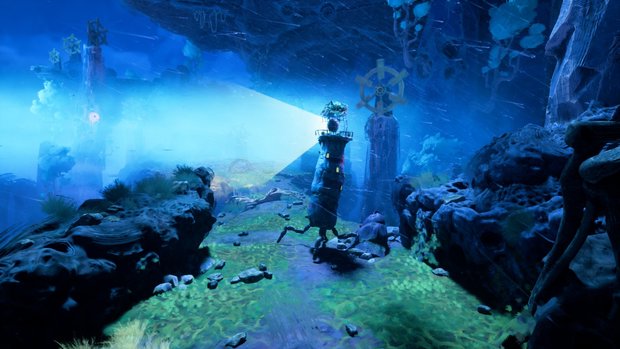
In a game without words, it’s imperative to get the music right and Keeper’s soundtrack is up to the challenge. It’s every bit as varied as the visual aesthetic, ranging from lonely bells and chimes to disturbingly discordant tones, New Age synths, Eastern-tinged melodies, moody violins, funky electronica, tribal percussion, and just about everything in between. I wasn’t nearly as impressed with the rest of the soundscape, unfortunately. Even with headphones on, the ambient sounds just don’t have the oomph they should have, including the lighthouse's footfall and Twig’s own “emote” on demand call, which is barely audible when it should be commanding full attention. Adjusting the default sound settings improved it some, but I’d have still preferred more organic audio verve. I’ll have to go back and fiddle with them some more.
And go back I definitely will – this from someone who normally despises replaying games. I can’t wait to dive back in and take more time to absorb the spectacle. Not that I rushed through the first time, taking five hours all told to reach the end, challenged enough to keep me fully engaged without ever becoming hopelessly stuck. There’s no hint system of any kind, which I initially thought was a mistake on occasion, as I felt a little lost in some of the more wide-open areas in the second half of the game. And yet my objective was generally clear soon enough, and inevitably with just a little more exploring I’d come across a new pulsating sac to obliterate with a light beam, another energy orb for Twig to pry away and collect, or a machine able to refract light in ways I couldn’t on my own, and I’d be on my way again.
Keeper is split up into 29 different chapters, but most of them are so seamless that it doesn’t feel that way. A few significant events occur that drastically change the conditions of your journey, such as being separated from Twig for a time after a precipitous fall, but for the most part the experience is a continuous – and continuously surprising and rewarding – one. There isn’t actually a great deal of replay value, apart from finding and restoring hidden shrines to the ancient “Time Elders,” but there aren’t that many and the chapter select screen doesn’t show which areas have unfulfilled achievements. Still, it's a nice backup to have, as the game uses an autosave checkpoint system to record your progress in between – not that you should ever have need to use it in a stable game with no deaths or game overs.
I get that narrative ambiguity is part of the charm of such games, but a little more integrated lore wouldn’t have gone amiss. As much as I enjoyed being there, I don’t feel I know this world any better now than when I started. (Of course, if this is just a ploy to release a separate artwork and lore book, the only relevant questions are: when and how much?) I wish greater focus was given to the relationship between the lighthouse and Twig, too. There are a few fun or touching moments, as clearly a bond of affection begins to grow between them, but more could have been done to emphasize it.
The bigger complaint in a game that warrants very few of them, however, is the camera. Namely, you have no control over it. For the most part it does a fine job of following your progress and giving you a decent view of the current scene (occasionally panning out for a larger-scale overview). But not always. Sometimes the angle makes it hard to make out exits that are already rather unnatural looking, cuts can occasionally (though thankfully rarely) be jarring, and shots of the lighthouse facing the camera are never particularly useful for planning where to go. More than anything, though, this world is just so gloriously lovely that it begs for the chance to view it at will.
Final Verdict
Whoever says you can’t have brains and beauty – and occasionally some old-fashioned brawn – has clearly never played Keeper. I do not use this word lightly, but to me it’s an artistic masterpiece. And yet it’s also a very entertaining game, blending familiar formulas from multiple genres into something daringly, creatively unique. Where most games play it safe, this game goes big and it’s all the better for it. Not all of its swings may land for everyone, particularly point-and-click purists disappointed in the shift away from leisurely puzzles to light platforming toward the end. But for anyone in search of something a little – or a lot – different, Keeper is not to be missed, serving as a shining beacon of light in an industry of relative sameness.
Hot take
Bold, beautiful, brilliant. Lee Petty and Double Fine have done it again. It’s a keeper, all right.
Pros
- Absolutely gorgeous artwork depicting a richly imaginative world
- Eclectic range of music keeps pace with the ever-changing environments
- Continually surprising blend of enjoyable genre elements
- Practically seamless gameplay experience
- Endearing relationship between two unlikely heroes
Cons
- No camera control
- Ambient sound is a little underwhelming
- Esoteric narrative could have been a bit better integrated
Jack played Keeper on PC using a review code provided by the game's publisher.










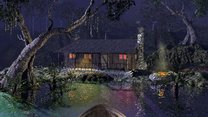
0 Comments
Want to join the discussion? Leave a comment as guest, sign in or register.
Leave a comment